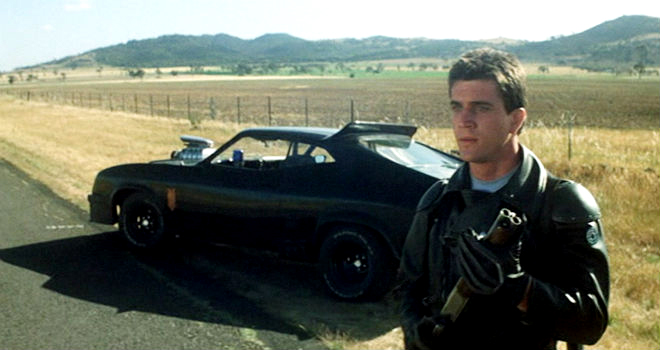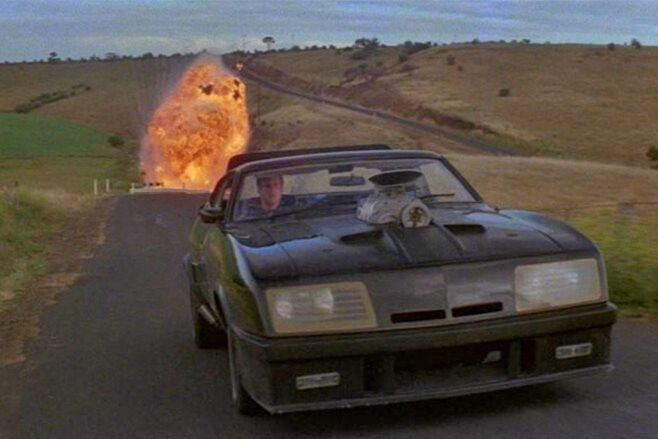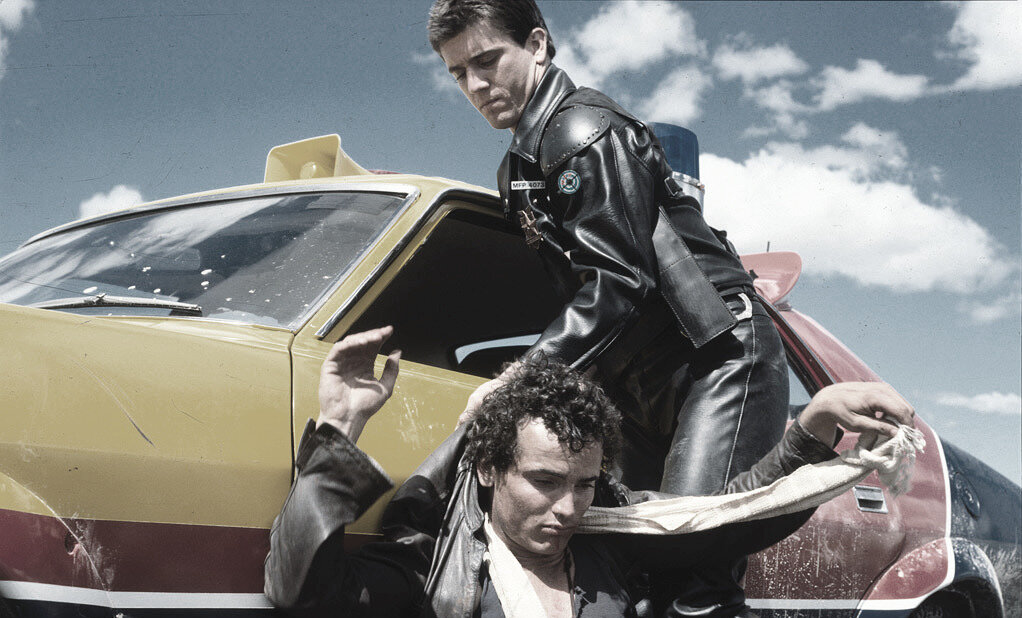What is Mad Max about?
The first movie of what would become a massive franchise, Mad Max uses the tropes of a standard 70s revenge thriller to trick people into watching a speculative science fiction story about societal collapse. George Miller explores how the institutions of civilized society curb the innate craziness of humanity. But what happens when those institutions fail? How long until the madness within all of us comes bubbling to the surface? Mad Max is about the tipping point in that battle between order and chaos.
Cast
- Max Rockatansky – Mel Gibson
- Jessie Rockatansky – Joanne Samuel
- Goose – Steve Bisley
- Fifi – Roger Ward
- Toecutter – Hugh Keays-Byrne
- Bubba – Geoff Parry
- Johnny the Boy – Tim Burns
- Mudguts – David Bracks
- Nightrider – Vincent Gil
- Labatouche – Jonathan Hardy
- Written by – George Miller | James McCausland
- Directed by – George Miller
The ending of Mad Max explained
Recap
The end of Mad Max begins following Toecutter and his gang running down Jessie and Sprog. Max, enraged, changes into his revenge clothes and gets his revenge car and heads off after the gang. He’s no longer operating within the bounds of the law. Slowly but surely, he eliminates each member, though not without suffering some injuries himself. A shotgun takes care of Bubba. A semi-truck erases Toecutter. And Max turns a wrecked car into a time bomb that consumes Johnny.
Meaning
Mad Max plays out like a kind of parable. The super/chyron at the beginning says “A few years from now…” which implies a kind of dystopian setting. The visuals reinforce this. The first shot is the gate to the Halls of Justice, but the “U” is askew. Its still dusk, so everything is gloomy. The subtext of this is a shadow has fallen over society. The International Bar Association states that “The Rule of Law is the foundation of a civilized society.” So what’s it mean, then, if the rule of law goes away? Where does that leave society?
The Main Force Patrol represents law and order. They protect society as we know it. While Toecutter’s gang embodies lawlessness and chaos. Everywhere they go, they threaten society. In between, you have people just trying to go about their normal, everyday life.
Pretty much every scene is about Order versus Chaos and people attempting to live normally in the midst of the conflict between Order and Chaos. When you have this in mind, the opening chase has a lot more nuance. It’s initially just cops chasing a criminal on the highway. Then the chase enters a town. And suddenly regular people have their lives threatened or upended. They’re caught in the middle. The same thing happens when the gang rides into a town to claim Nightrider’s body. The day to day is upended. Rules go out the window. And people suffer.
Look at this conversation between Max and his captain when Max tries to quit.
Fifi: They say people don’t believe in heroes anymore? Well, damn them! You and me, Max. We’re gonna give them back their heroes.”
Max: Fif, do you really expect me to go for that crap?
F: … Give me a reason [for quitting].
M: I’m scared, Fif. Do you know why? It’s that rat circus out there. I’m beginning to enjoy it. Any longer out on that road, and I’m one of them, you know? A terminal crazy. Only I’ve got a bronze badge to say I’m one of the good guys.
Order isn’t winning the war. This is especially obvious when Goose and Max arrest Johnny the Boy. It should be an open and shut case. But the courts fail. Johnny’s free to go. And he and the gang immediately get revenge by killing Goose.
When Max quits, he tries to, like so many others in the film, be normal, prosaic. To have the kind of life you could have in a healthy society. Crossing paths with the gang shouldn’t be viewed as coincidental so much as inevitable. As they represent the impossibility of normality in a world where society can’t be maintained. The destruction of Max’s family symbolizes just that. It’s the tipping point. The end of the world as we’ve known it.
Max, then, becomes “one of them”. A terminal crazy. He gets justice but it’s not the ritualized justice of civilization. It’s primal. And it’s not just his actions that confirm this. It’s the car, too. In the very beginning, Max drives an Interceptor—while Nightrider’s in a stolen Pursuit Special, one of the rarest cars in this universe. The Pursuit Special is the exact model Max has at the end. Narratives often use this kind of resonance to show a character coming full-circle. Usually, it’s in a positive way. Like Into the Spider-Verse opens with a situation where Miles helplessly watches Peter Parker do all kinds of amazing Spider-Man stuff. Then Miles becomes Spider-Man and can’t do any of it. Until the very end. Then he’s in that exact location where he watched Peter, except this time Miles is saving the day.
Mad Max does the opposite. The hero becomes another broken person in a broken world. And because he represents the broader idea of order, of rule of law, the implication of the ending is huge. As it means the world is about to go mad, the same as Max. An idea that Miller will explore in the sequels.

The themes, message, and meaning of Mad Max
Everyone is a bit crazy
Mad Max extends the idea of order vs chaos into the notion of the sane versus the insane. The police, as part of the judicial system, as agents of order, should be sane. While the criminals, the chaotic horde, are insane. That’s why Max says he’s afraid that if he remains out on the road that he’ll become a “terminal crazy” like the others.
Except no one in Mad Max is really all that sane. The members of the MFP are all pretty outrageous themselves. Even the regular citizens. A family lets their child run out into the road and don’t even notice. People are making illegal turns with a tow behind RV. Whoever left Nightrider’s body on the train platform. How does Max’s wife, Jessie, tell Max she loves him? She “signs” the phrase “I’m crazy about you.”
So you could make an argument that Mad Max takes the stance that craziness is an inherent part of humanity and that it will, inevitably, be the downfall of society. Yes, there is, in this world, an oil shortage and environmental decline. But those things aren’t what destroy humanity. They simply unlock the craziness we all already have inside of us that polite civilization as we know it has managed to, thus far, quell. When civilization starts to break down, all bets are off.
Why is the movie called Mad Max?
The title refers to the change in Max’s character. He starts off as one of the good guys, a heroic figure. But, by the end, he’s become one of the terminally crazy. A bit of dialogue formalizes this. It comes at the very end, when Max cuffs Johnny’s ankle to a car that will blow up any second then hands Johnny a hacksaw and explains that it will take ten minutes to cut through the chain or five minutes to cut through an ankle. Johnny’s response to the punishment (which probably had a lasting impression on Jigsaw from Saw) is to scream out: “You’re mad, man.”
Johnny had spent the film talking about his own diagnosed psychopathy. So for him, a person clinically labeled insane, to call Max a madman…well…that means Max has become a madman.
Of course, it also refers to Max’s desire for revenge. The gang murdered Max’s wife and son. So he’s “mad” in the traditional sense. But that masks the deeper, secondary reading that he’s actually gone mad. Which, of course, serves as a metaphor for the world as a whole losing its sanity.
Important motifs in Mad Max
Max dressed in slacks and a button down
The scene where Max and Jessie stop to get a tire fixed is the embodiment of how far gone the world is. He’s dressed in slacks and a button-down shirt. The shirt tucked in. He has a belt. He looks like a sales rep from Sydney’s central business district. Meanwhile, they’re stopped in a junkyard, surrounded by broken down family sedans, just like the one they’re driving. He looks so incredibly out of place that it’s pretty hilarious. Jessie then drives into town for an ice cream. A perfectly normal thing to do. Except for Toecutter’s gang hanging around. The gang interrupts the idea of normalcy that Jessie and Max are attempting. It’s a normalcy that’s already dead.
When Max runs to the bodies of Jessie and Sprog, he’s in those same cream slacks and a white undershirt. It’s a bright palette. After he leaves the hospital, he changes to all black, all leather. An outfit more befitting for the road ahead.
Johnny goes free
In a just world, Johnny should go to jail for what he and the rest of Toecutter’s gang did to the man and woman they assaulted. He was caught at the scene of the crime. There’s a witness to positively identify him. It’s open and shut. Except Johnny goes free. Why?
Technically, it’s because the girl wasn’t there to testify. Without the witness, how could they charge Johnny? But we’re told that not only did the girl not show, but “no one showed.” The townspeople, the witness. There weren’t enough ingredients for a trial. Thematically speaking, this is one of many moments that demonstrate the idea that the rule of law is gone. And it serves as a tipping point in Mad Max. Up to this point, order had still had the upper hand. But after the failed trial, the gang starts wreaking havoc.

Questions & answers about Mad Max
Do we know what’s happening outside of Australia?
Not really. At the start of Fury Road and Furiosa, we hear snippets from various news reports that talk about the state of the world. The gasoline wars. The water wars. Things like that. But the primary location seems to be the Australian outback. Though Beyond Thunderdome drifts into Sydney.
What year does Mad Max take place?
The only indication of the year is the opening that says “A few years from now…” If you take the literal release year of 1979 as the “now” then it would be sometime in the 1980s. Which makes sense. Road Warrior is only a few years after Mad Max, so still the 1980s. Thunderdome is 15-ish years later. So early 2000s.
But Fury Road and Furiosa are weirdly situated because they came out so far after the original trio of films. It seemed Miller initially intended to make Fury Road in the 1990s and it would happen right after Thunderdome. But then a lot of time passed. So the timeline of the films is a bit amorphous. But Mad Max is definitely intended to be the 1980s.
Why did Nightrider start crying? Why does he say “It’s going”?
This is an interesting one. I believe it has to do with the game of chicken he and Max play. Nightrider’s all egotistical until he plays chicken. While Max stays calm and collected, Nightrider breaks. He swerves first. Which is a kick right in his masculinity and sense of badassery.
But Nightrider is also a madman. And it’s like Miller gave him a moment of clarity to speak on what’s about to happen to the world. I think that’s what Nightrider means when he says “It’s going. There’ll be nothing left. It’s all gone.” It’s like the game of chicken brought him to the brink of death and suddenly he had a vision of what would come next—the downfall of civilization. And then he goes boom.
Now it’s your turn
Have more unanswered questions about Mad Max? Are there themes or motifs we missed? Is there more to explain about the ending? Please post your questions and thoughts in the comments section! We’ll do our best to address every one of them. If we like what you have to say, you could become part of our movie guide!


Nobody goes for Toecutter’s body, as he doesn’t die until the end of the movie with the gang (except for Johnny) wiped out. It’s Nightrider’s body the gang is after.